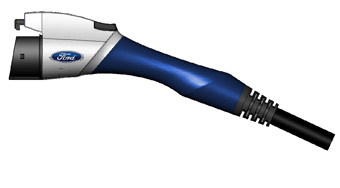
Ford Motor Co. ergonomics engineer Cary Diehl studied a variety of consumer products, including some totally unrelated to the automotive industry, in order to come up with the perfect shape for the new Focus electric-vehicle’s recharging handle.
Diehl looked at things “people grip for an extended period of time and every day, including curling irons,” he tells Ward’s in an interview.
“We thought about what people are interacting with on a daily basis,” he says. “Ergonomics is something you typically don’t notice unless it’s done badly.”
Other items studied included hockey sticks and tennis rackets. He also looked at traditional fuel-pump handles.
What Diehl found was that most of the items shared common characteristics. “You could see they all had the same size handle, which works for smaller, female hands and larger hands,” he says.
The new Focus EV, due to arrive in the U.S. in late 2011, will come standard with the Ford-branded handle.
The car’s 120V cord will allow users to recharge the all-electric car at remote locations, serving as a backup for the optional 240V home-charging station to be offered by Ford.

While both types of connectors will use an industry-standard 5-point plug, Diehl says he believes Ford is the only auto maker to date to put so much thought into the ergonomics of the device.
“But I suspect (the same kind of thought) went into (traditional) fuel fillers when they were invented way back when,” he says.
Attention also was paid to the positioning of the vehicle’s recharging point in relation to the charging handle.
Working with Yazaki North America Inc., the supplier that will produce the handle, consumer workshops were conducted in which participants were allowed to move the charging point, attached to an articulating arm, to the best ergonomic position.
The key element was coming up with a handle and charging-point position that would fit all sizes of user hands, Diehl says. One early prototype presented to him resembled a small “1980s cell phone,” which he decided wasn’t going to work.”
The finalized version of the charger has less of an angle than a pistol grip, and studies indicated it was not fatiguing, even after multiple uses.
While coming up with a sleek, ergonomic design was a priority, the handle also had to meet engineering standards, which somewhat limited the possibilities, Diehl says.
The Society of Automotive Engineers says “you have to have a handle you can run over, and it has to be a certain size so you don’t break it,” he says.
“We had to compromise, and the (design) studio had ideas that were different, because studios and ergonomics don’t always agree. But everything balanced out in the end.”
The final step in the design of the recharging handle was developing an appropriate coating, and this sent Diehl back to the research phase.
“A golf-ball kind of texture was our recommendation,” he says, noting the grip chosen for production “has a good texture with dimples.”
Ford declines to reveal if the same handle will be offered on its other upcoming EVs, or if a different design will be developed.
The auto maker plans to deliver five new EVs over the next three years in North America and Europe.



